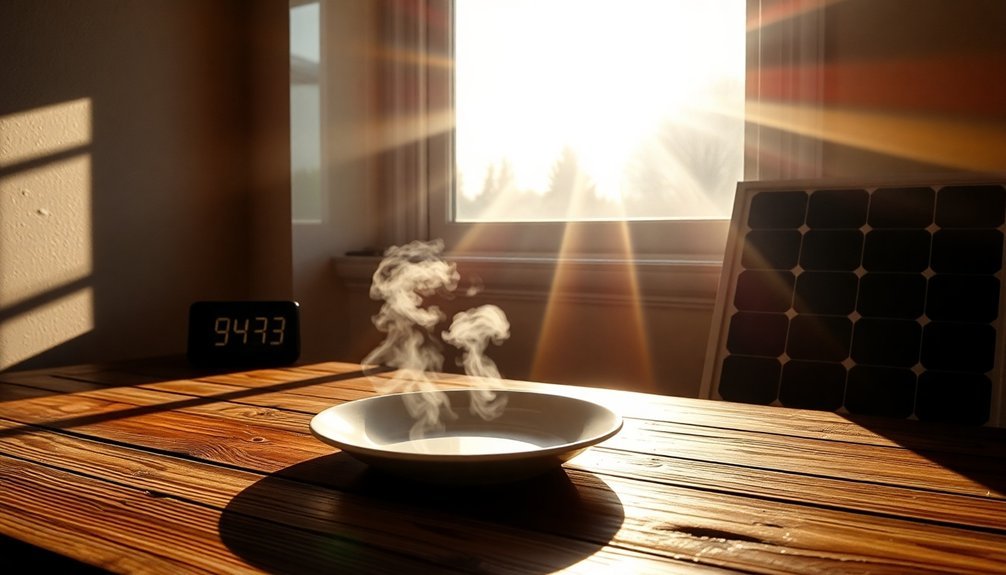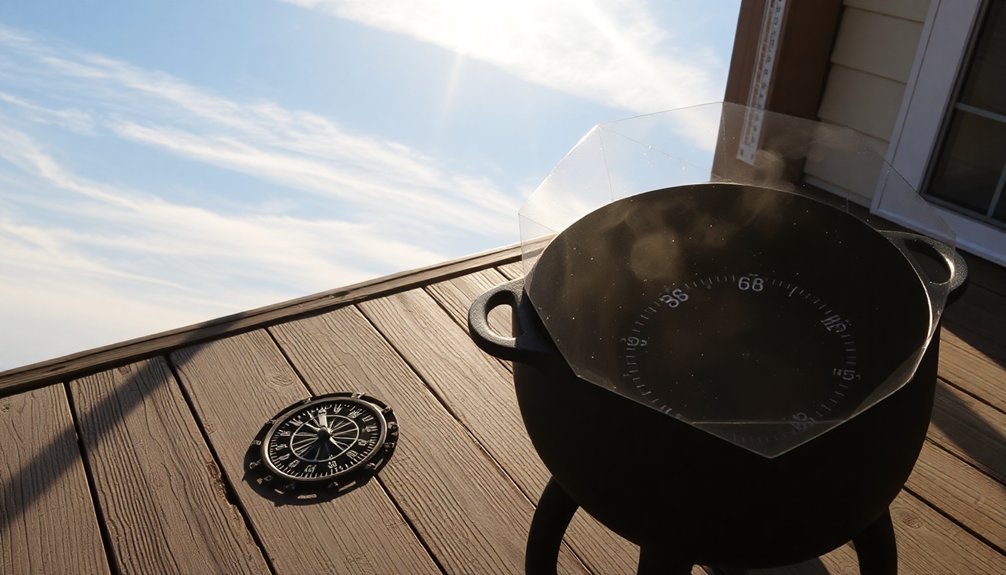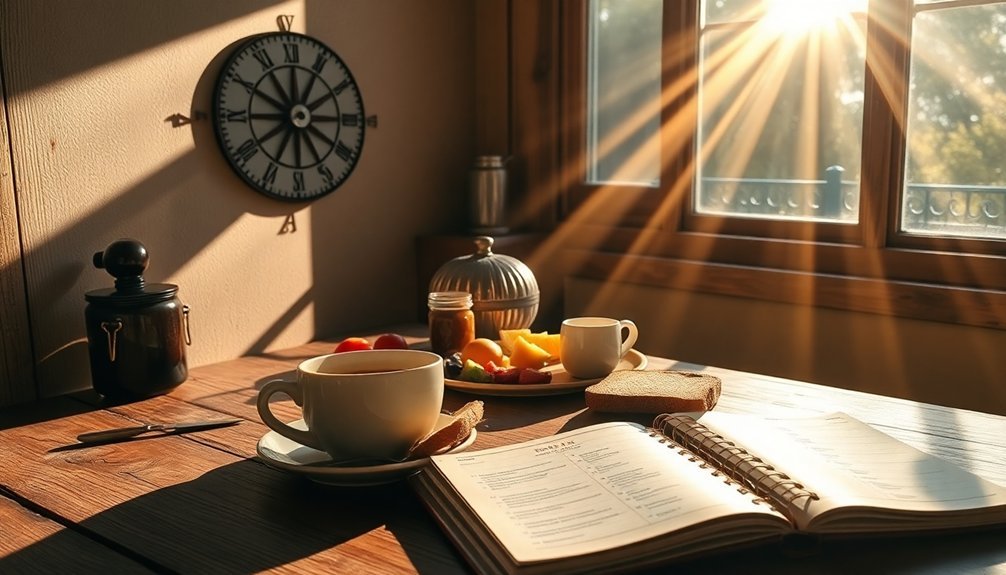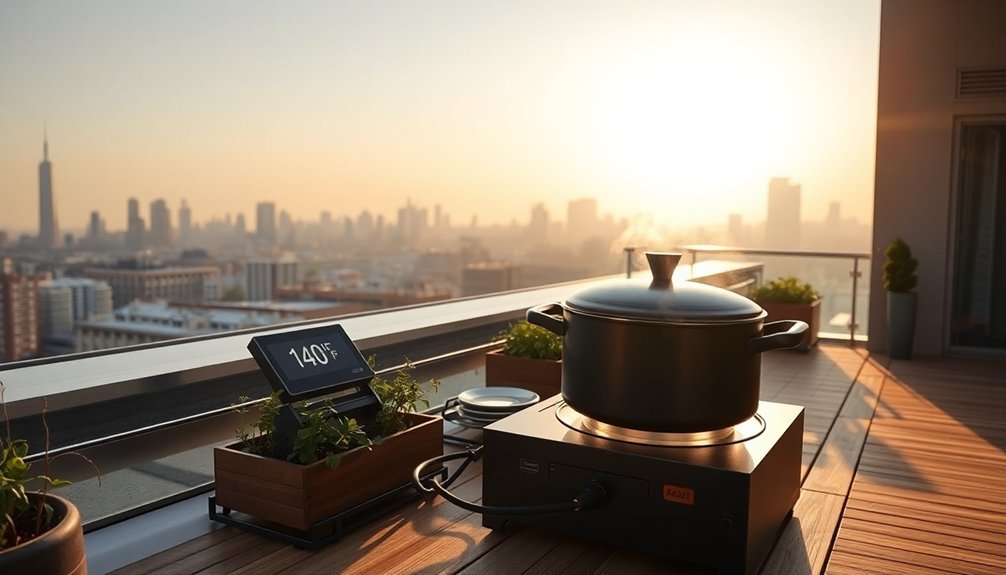You can start your sun-powered cooking as early as 10:00 AM today, but you'll get the best results between 11:00 AM and 3:00 PM when the sun is strongest. You'll want to orient your solar cooker facing east for noon meals and adjust it every 20-30 minutes to track the sun's movement. Cloud cover might increase cooking times, so choose a sheltered spot with good sun exposure. For ideal results, check the intensity of shadows – darker shadows indicate better cooking conditions. The right timing and positioning techniques will help reveal the full potential of your solar cooking experience.
Your Local Solar Window

While traditional solar panels dominate rooftops, solar windows are revolutionizing how you'll collect energy through your home's existing openings. Your windows can now convert sunlight using tiny solar cells positioned at specific angles near the frame, with solar concentrators that funnel light to maximize absorption.
You'll see these innovative windows start working instantly when exposed to light, changing color throughout the day to capture peak energy across the solar spectrum. Each window generates 8-10 watts daily – enough to charge your phone twice per meter.
Though they're less efficient than conventional panels, converting about 10% of sunlight versus 20%, they'll still provide reliable energy collection even without ideal exposure. Plus, you can integrate them into various building elements, making them perfect for homes with limited roof space. Over their lifetime, these innovative windows can help reduce environmental impact by offsetting 100 tons of CO2.
Best Hours For Solar Cooking
Because the sun's position directly affects cooking temperatures, solar cooking works best between 11:00 am and 3:00 pm when sunlight is most intense. Using box-type solar cookers can help maintain consistent temperatures for several hours. You'll achieve higher temperatures and faster cooking times during these peak hours, making them ideal for baking bread and cakes.
You can start cooking as early as 10:00 am to preheat your solar oven, especially if you're planning a noon meal. For evening dishes, begin by 1:00 or 2:00 pm and angle your cooker westward.
During winter months, you'll need to adjust your cooker more frequently since the sun sits lower on the horizon. Summer offers longer cooking windows with fewer adjustments needed.
Check your shadow to gauge sunlight intensity – a darker shadow means stronger rays and better cooking conditions. Even on slightly cloudy days, you can still cook successfully, though it'll take longer.
Weather Impact on Cooking Time

Various weather conditions can greatly affect your solar cooking experience.
You'll need to take into account cloud cover, wind patterns, and temperature when planning your solar-cooked meals. On cloudy days, expect longer cooking times and make adjustments by using additional insulation or booster panels. Optimal cooking performance occurs during 11:00 AM to 3:00 PM when UV rays are strongest.
If you're cooking in cold weather, you can enhance your oven's performance by adding thermal mass like rocks or bricks to retain heat.
Wind can disrupt your cooking process, so find a sheltered spot to protect your oven. During winter months, you'll face additional challenges from lower sun angles and shorter daylight hours.
To maximize efficiency, preheat your oven early and reposition it regularly to track the sun.
Remember to use a cooking thermometer to guarantee food safety, regardless of weather conditions.
Positioning Your Solar Cooker Today
Getting your solar cooker properly positioned is essential for achieving ideal cooking results. You'll need to orient your cooker's shorter front panel eastward for noon meals or westward for evening cooking. Place it on a level, dry surface and check that its shadow falls directly behind it for proper alignment. For optimal cooking performance, aim to start your solar cooking between 10 AM and 2 PM.
| Position Element | What You Need to Do |
|---|---|
| Base Stability | Add stones or bricks on sides |
| Pot Setup | Use wire rack for air gap |
| Sun Tracking | Adjust every 20-30 minutes |
| Wind Protection | Create barriers as needed |
Don't forget to verify your cooker's stability by securing the front panel's flaps with clothespins and raising your pot on crossed wires. For maximum efficiency, you'll want to maintain a clear line of sight to the sun and adjust your reflectors hourly to match the sun's movement.
Meal Planning Around Sunlight

Once your solar cooker is properly positioned, you'll need to think strategically about which meals work best with available sunlight.
Plan dishes that align with seasonal produce and peak sun hours. In summer, you can prepare water-rich vegetables like tomatoes and cucumbers, while fall and winter call for heartier root vegetables and squashes that benefit from longer cooking times.
Map out your weekly meals by checking which ingredients you already have and creating a grocery list focused on seasonal options.
You'll want to prep ingredients in advance, especially for morning solar cooking. Consider making breakfast items like oatmeal with preserved fruits early in the day, and save dishes requiring longer cooking times, such as stews and roasted vegetables, for midday when sunlight is strongest.
Frequently Asked Questions
Can Frozen Foods Be Cooked Directly in a Solar Cooker?
Yes, you can cook frozen foods directly in your solar cooker without thawing. Just make sure you've preheated the oven and focused it correctly. The cooking time will vary based on your food's size.
How Do Different Colored Cooking Vessels Affect Solar Cooking Efficiency?
You'll get the best solar cooking results with dark-colored vessels since they absorb more heat. Light or shiny pots reflect sunlight away, reducing efficiency. Dark enamel or speckleware vessels are your most effective choices.
Is It Safe to Leave Food Cooking Unattended in a Solar Cooker?
While it's technically possible to leave food cooking, you shouldn't leave your solar cooker unattended. You'll need to monitor temperatures, adjust positioning, and stir foods regularly to guarantee safe, even cooking.
What Materials Should Never Be Used in Solar Cooker Construction?
You shouldn't use untreated cardboard, toxic materials that emit fumes when heated, glass for sides/bottom, or uninsulated metals. These materials can reduce efficiency, create safety hazards, or deteriorate quickly in your solar cooker.
Do Solar Cookers Work Effectively at High Altitudes?
Yes, you'll find solar cookers work exceptionally well at high altitudes. Your cooking will benefit from increased direct radiation, clearer skies, and less atmospheric interference, making your meals cook more efficiently than at lower elevations.
In Summary
You'll get the most effective solar cooking between 10 AM and 2 PM when the sun's intensity is strongest. Position your cooker early to catch these peak hours, but remember that your local weather conditions will affect cooking times. If you're planning a sun-powered meal today, start your prep work by 9:30 AM to make the most of the available solar window. Check your forecast and adjust accordingly.





Leave a Reply